Bench sit-ups are one of the most popular abdominal exercises, and for good reason. They’re easy to do, work well, and can be adjusted to suit your needs. Because of their simplicity and effectiveness, they are a staple in many fitness routines.
The decline crunch may be an old-school exercise, but make no mistake, it’s also one of the most effective core exercises, that target the rectus abdominis (particularly the upper abs) and obliques
Unlike a regular sit-up, where you lie on the ground, the bench sit-up requires you to sit on an exercise bench with your feet planted firmly under the foot pad.
The bench sit-up forces you to rely on your core strength to complete the movement without stabilizing your feet on the floor. This leads to a greater activation and contraction of the abdominal muscles than a conventional sit-up.
Bench Sit-Ups Other Names: slanted bench sit-ups and decline sit-ups.
Try Our Free Calculator To Know Your Body Fat Percentage

Bench Sit-Up Muscles Worked
Sit-ups primarily target the abs muscles, whether performed on the floor or on an incline bench.
- Primary Muscles Worked: Rectus Abdominis and External Obliques
- Secondary Muscles (Synergists and Stabilizers): Hip Flexors (Iliopsoas, Rectus Femoris), Tensor Fasciae Latae, Transverse Abdominis and erector spinae
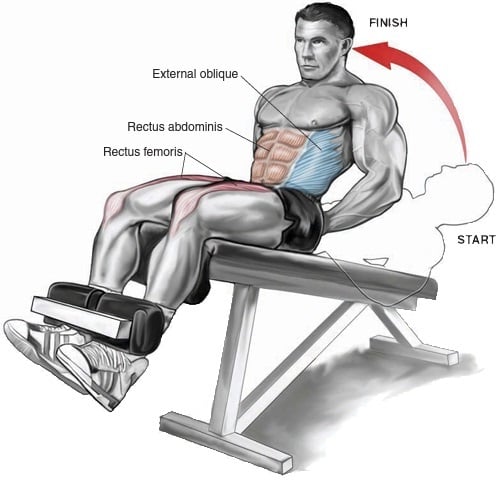
Use our free calculator to know your weight loss calories requirement.
How To Do Decline Bench Sit Up
The decline bench sit-up is an advanced version of the traditional sit-up performed on a slanted bench set.
This position makes the exercise harder because your abs muscles have to work harder because of the pull of gravity.
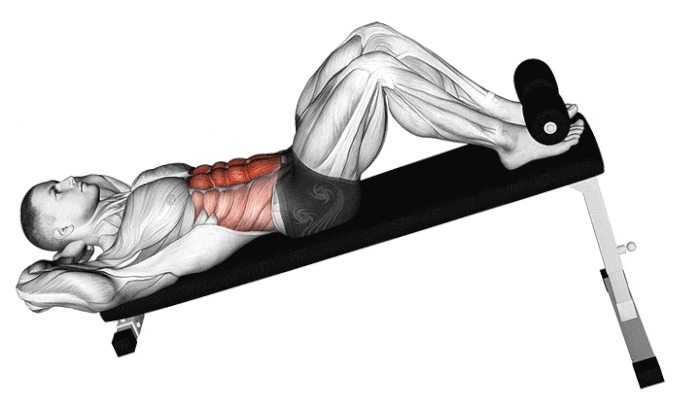
- Adjust the bench to your desired decline angle. The steeper the angle, the more challenging the exercise will be.
- Lie down on the bench with your ankles secured under the footpads.
- Your body should be aligned with the bench, with your head lower than your feet.
- Cross your arms over your chest, extend them in front of you, or place them lightly behind your head.
- Contract your abs and raise your torso as high as your abs allow without sitting down completely. Exhale during this phase.
- Lower yourself back down while inhaling, but without letting your shoulders and upper back touch the bench.
Tips For Proper Form
- Always activate your core before initiating the movement.
- If new to decline sit-ups, start with a slight decline. You can increase the decline angle as you become stronger and more comfortable.
- Keep your back straight throughout the exercise to avoid straining your lower back.
- Use a smooth, controlled movement both during ascent and descent.
- Lightly touch the back of your head with your fingers without pulling or crossing your arms over your chest.
- Keep feet flat and anchored, but ensure the effort is from the core, not the hip flexors.
- Aim for a full range of motion, from a flat back position to sitting upright.
- It’s more beneficial to perform fewer sit-ups with proper form than many with poor form.
- You can set the bench to any incline angle, as long as you can perform your crunches with good technique. If you find that the angle you are using is too taxing, set the bench to a slightly less inclined angle.
- Never use your hands to pull on your head. Not only is this bad for your neck, but it also prevents you from optimizing the engagement of your abdominal muscles.
- To make the exercises more challenging, You can hold a weight plate or dumbbell on your chest or behind your head.
To Stay Motivated: 150+ Gym Workout Motivational Quotes To Stay Fit
Bench Sit Up Variations
Looking to add some variety to your ab workout? There are many different variations of bench sit-ups that you can incorporate into your routine to target different muscles and increase the difficulty of the exercise.
Target your abs from all angles and continually challenge your core with these effective bench sit up variations.
1. Twisting Bench Sit-Up
A decline sit-up bench positions your upper body at an angle so that it’s lower than your hips and thighs. It is a challenging exercise for developing the upper abs.
This position causes your body to work harder, since you have to work against gravity and through a wider range of motion.
It’s a great exercise for intermediate to advanced lifters because it is moderately challenging but very effective for its intended purpose.
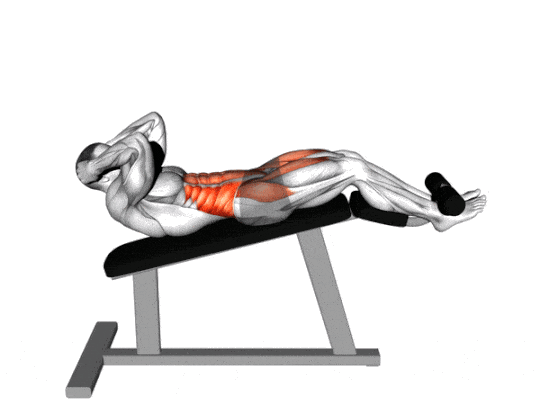
How To Do It
- Sit on the decline bench, hook your feet under the pad, lean back, and position your hands behind your head.
- As you sit up, twist your torso, directing your right elbow toward your left knee.
- Reverse the motion and lower your torso to the starting position; during the next repetition, direct your left elbow toward your right knee.
- Keep repeating and alternating the side to which you twist your waist.
2. Weight Decline Bench Sit-Up
Adding weight to the exercise increases its resistance and makes it more challenging. The extra weight makes the muscles work harder, which could strengthen the abs.
Weight decline bench sit-ups are also a great exercise for burning calories. The added weight increases the intensity of the exercise which increases the number of calories burned during the workout.
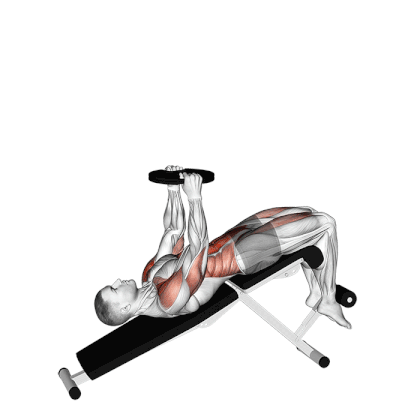
How To Do
- Adjust the decline bench to an angle of between 30 and 45 degrees.
- Sit on the bench with your legs resting on the leg pads and your feet secured.
- Hold a weight against your chest or overhead.
- Tighten your abdominal muscles and lift your upper body off the bench.
- Lift your body up until your upper body is completely vertical.
- Lower your body back down to the starting position.
- Don’t rush the exercise. Take your time and control the movement.
3. Flat Bench Sit-Up
Unlike incline bench sit-ups, the flat bench allows for a greater range of motion. You can lower your back all the way down, really stretching those abs before powering up. This increased range means more muscle engagement and better results.
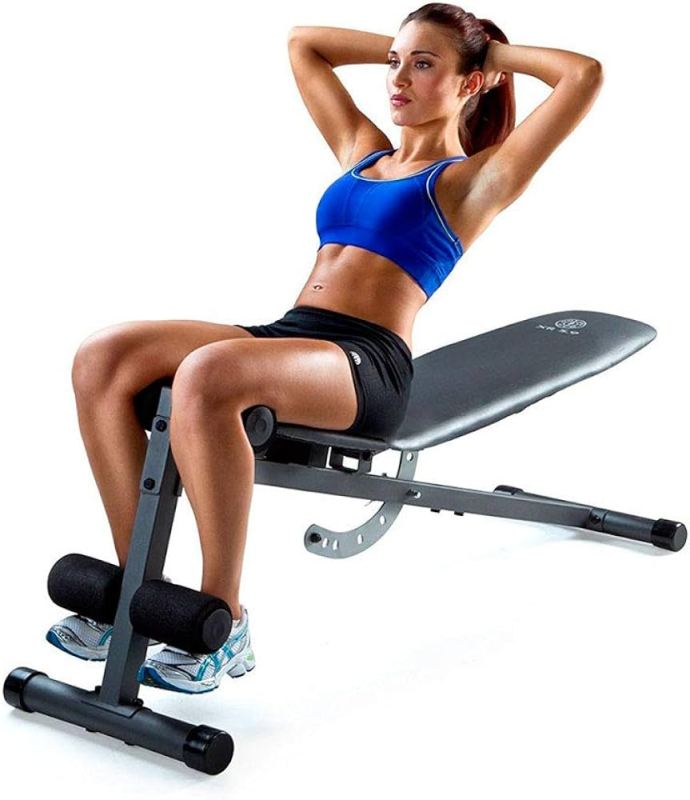
How To Do
- Lie down on a flat bench and secure your feet under the foot holders or have your workout partner hold them for you.
- Place your hands behind your head, cross them over your chest, or extend them in front of you.
- Tighten your abdominal muscles and lift your upper body off the bench.
- As you rise, ensure that you’re leading with your chest and not pulling your head forward. This will help avoid undue stress on the neck.
- Slowly lower your upper body back to the starting position
FAQs
Incline Bench Sit Up Vs Decline Bench Sit Up
Both incline and decline bench sit-ups are variations of the classic sit-up, performed on an adjustable bench.
The terms “incline sit-ups” and “decline sit-ups” are often used interchangeably, but they describe the same exercise. Both refer to performing a sit-up on an inclined or declined bench.
The common term used in most fitness circles for sit-ups performed with the head lower than the feet (making the exercise harder due to gravity) is “decline sit-ups.” The bench used for this is often called a decline bench.
What is the hardest form of sit-up?
The weight decline sit-up is the hardest form of sit-up. This variation increases the resistance and challenge by holding a weight against your chest or overhead while performing the exercise on a decline bench.
How many bench sit-ups a day?
There is no one-size-fits-all answer to the question. It depends on your fitness level.
- For beginners: Start with 1–2 sets of 10–15 reps, 1–2 times per week.
- For intermediate: Build up to 2–3 sets of 15–20 reps, 2–3 times per week.
- For advanced: Can do 3–4 sets of 20–30 reps, 2–3 times weekly.
References
- Kumar, R., & Zemková, E. (2021). The Effect of 12-Week Core Strengthening and Weight Training on Muscle Strength, Endurance and Flexibility in School-Aged Athletes. Applied Sciences, 12(24), 12550.
- Childs, John & Teyhen, Deydre & Benedict, Timothy & Morris, Jamie & Fortenberry, Andrew & McQueen, Rene & Preston, Janice & Wright, Alison & Dugan, Jessica & George, Steven. (2009). Effects of Sit-up Training versus Core Stabilization Exercises on Sit-up Performance. Medicine and science in sports and exercise. 41. 2072-83. 10.1249/MSS.0b013e3181a84db2.

Manish is a NASM-certified fitness and nutrition coach with over 10 years of experience in weight lifting and fat loss fitness coaching. He specializes in gym-based training and has a lot of knowledge about exercise, lifting technique, biomechanics, and more.
Through “Fit Life Regime,” he generously shares the insights he’s gained over a decade in the field. His goal is to equip others with the knowledge to start their own fitness journey.
